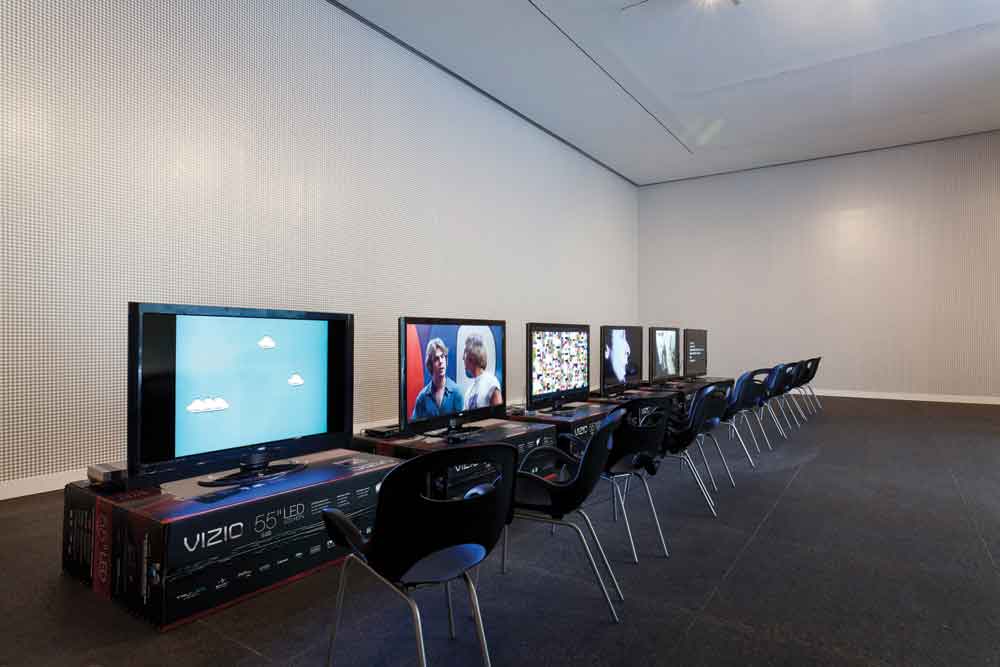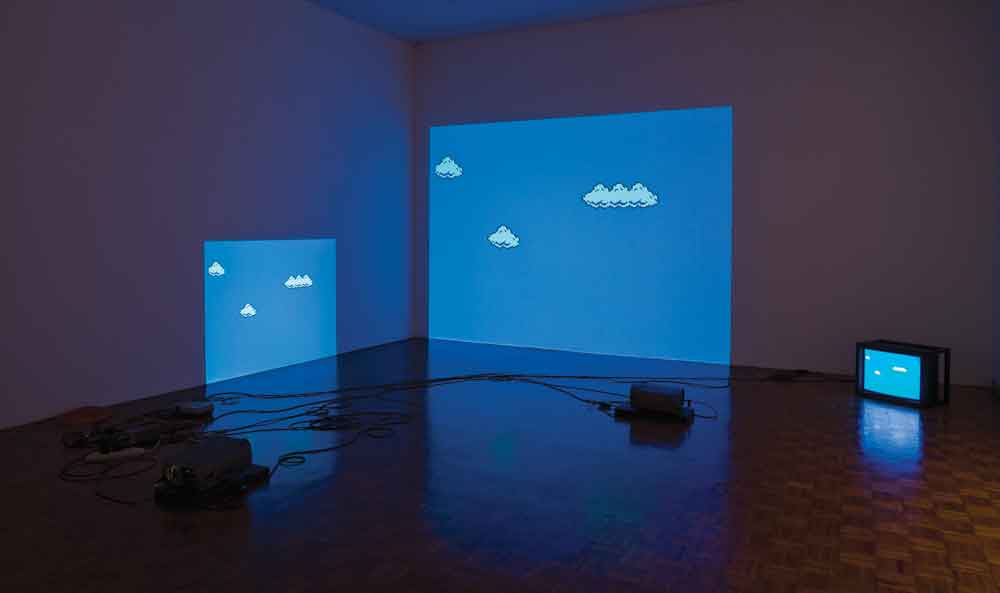« Reviews
Cory Arcangel: Masters
Carnegie Museum of Art - Pittsburgh
Curated by Tina Kukielski
By Stephen Knudsen
No longer do most of us give a second thought to the invasion of lowbrow [pop]ulism in the elitist white cube. Warhol’s Marilyns and Elvises have begotten Koon’s puppies, Hirst’s sharks, Murakami’s superflats, and much more. The ubiquity of such work asks a simple question: Why should speed, spectacle and celebrity only intoxicate us in the streets and our homes? Why not the museum? Framed in this way, Cory Arcangel’s survey exhibit “Masters“ seemed-in theory-on track for an “A” game as it promised to ask an even deeper question about speed: As we blow through endless upgrades of hardware and software in our glorious skim on the information superhighways, where is it exactly that we think we are going?
Adding further promise to this exhibit was the chosen venue, Pittsburgh’s Carnegie Museum located in Warhol’s hometown and just across town from the Warhol Museum. I scheduled to be at the museum for a full day, from open to close, to view the exhibition, a reflection of Arcangel’s work since 2002.

“Cory Arcangel: Masters.” Exhibition view. Carnegie Museum of Art, Forum Gallery. Photo: Tom Little.
Despite my better intentions, in the end I felt mostly unease (verging on embarrassment) for veneration of simplistic videos of YouTube cats, cardboard box pedestals and other altered ready-mades. For instance, to view Klavierstücke op. 11 (2009), one was to sit in a chair equipped with headphones and then watch quick edits of various cats supposedly walking out Arnold Schoenberg music on piano keys. Now, to some people, the atonal music of Schoenberg does sound like cats randomly walking on piano keys. But be assured, Arcangel’s appropriated and staccato cat clips sound almost nothing like Schoenberg’s 12-tone row. I am not sure Schoenberg himself would have recognized his music in the piece. The real problem with the work is that it better belongs back where it came from-on YouTube. Arcangel seems to agree with at least part of that sentiment, as he has posted it on YouTube where at last count it had 87,000 hits, 130 “likes,” and was brimming with comments like “f-ing amazing.” I must then ask what kind of importance can this add to art’s critical discourse in the museum?
Sliding to the next monitor, one was invited to view Untitled Translation Exercise (2006), the full-length feature of Richard Linklater’s 1993 teen cult film Dazed and Confused. Arcangel appropriated the full 103 minutes of the film, including the iconic opening: the orange 1970 Pontiac, “The Judge”, rounding the lot to Aerosmith’s hit song Sweet Emotion. Roger Ebert’s review (concurrent with the 1993 film release) praised Linklater’s artistry stating, “The years between 13 and 18 are among the most agonizing in a lifetime, yet we remember them with a nostalgia that blocks out much of the pain.” This is a truth well understood by Dazed and Confused, Linklater’s film about the last day of school and the long night that follows it. The film is art crossed with anthropology. It tells the painful underside of American Graffiti.”1
In a demonstration of vacuous buffoonery Arcangel dubbed the English dialog of Linklater’s film with new voices (still in English). Arcangel downloaded a free copy of the script and sent it to Bangalore so the new voices would have British/Indian accents. Meaning beyond the joke is thin at best especially when the artistry of Linklater (even so dated) far outshines any strip-mining by Arcangel. In other words, the piece remained more Dazed and Confused than Untitled Translation Exercise.
Then it was on to the next monitor and so on.

Cory Arcangel, Sweet Sixteen, 2006, Dual-channel video, color, sound, 15:55 min Courtesy of the artist and Team Gallery, New York
In a separate museum gallery, Sweet Sixteen (2006) was given a higher position on the big screen in the theater-like space. The work is a dual-channel video installation of the first 64 measures of the appropriated Sweet Child of Mine stage video by Guns and Roses. The two video channels, playing simultaneously, move in and out of phase (almost imperceptibly on a first listen) as the iconic song intro looped.
Now, I appreciate R. Mutt smartassness as much as anyone, especially when the fooling around with dated bites of culture is also trying to add something relevant to the critical discourse. But I question the vitality of some of the work in Masters when it is barely more interesting than what one might find through a search of the un-appropriated original material on the Internet.
Something more is needed. Arcangel has proven before that at his best he is astonishingly capable of delivering more. Consider the artist’s answer to Warhol’s Silver Clouds (1966): Arcangel’s Super Mario Clouds (2003). His piece is thought-provoking and dare I say a beautiful work the way the artist originally made it for the Whitney Museum of American Art’s permanent collection. I was left wishing the Masters exhibit had used this version.

Cory Arcangel, Super Mario Clouds , 2002- (installation view, “Synthetic,” Whitney Museum of American Art, 2009), modified Super Mario game cartridge; Nintendo System. Whitney Museum of American Art, New York © Cory Arcangel. Courtesy of the artist and Team Gallery, New York.
Arcangel hacked and modified the eight-bit computer in the obsolete Super Mario video game so just the puny clouds float endlessly across a big, blue screen. Museum text by “Masters” curator Tina Kukielski gets it right, stating, “The work operates as both pop icon and dystopian dream.” The piece is also theoretically relevant. It both confirms and denies art critic Boris Groys’ argument that digital artwork must change as it is re-translated as technology advances (90). It is true that Clouds could be displayed on endless reinventions of a screen, but the hardware/software of Clouds will always be the hacked game cartridge and untranslatable into other technology.
Unfortunately for the 2012 “Masters” survey exhibit, the theatre ambiance of Clouds was dumbed-down into a small monitor placed next to the monitors mentioned above. Clouds put in the context of simplistic recorded video gags made Clouds like a video recording as well. Thus, the key aspect of the work was lost: that Clouds was not recorded data but was being created in real time from an actual altered Nintendo gaming system. To see Clouds on the much-more-effective big screen in a darkened room (with long cords tethering the gaming system), I had to go to a concurrent group exhibition at the Metropolitan Museum of Art, NY (”Regarding Warhol: Sixty Artists Fifty Years”2). In the Met exhibit, Clouds was given the respect it deserved and thus was a highlight in this group exhibit bursting at the seams with iconic works by 60 of some of the most important contemporary artists who have been influenced by Warhol. The best Warhol works exemplify an answer worth emulating. Take popular culture to the museum, but in doing so make sure the soup has spice.
(November 3, 2012 - February 27, 2013)
Works Cited
- Groys, Boris. Art Power. Cambridge, MA: MIT Press, 2008.
Notes
1. Roger Ebert, September 24, 1993, Chicago Sun Times
2. “Regarding Warhol: Sixty Artists Fifty Years” has since moved from the Metropolitan Museum of Art, New York to the Carnegie Museum of Art, Pittsburgh, PA. (February 3 - April 28, 2013)
Stephen Knudsen is a professor of painting at Savannah College of Art and Design and exhibits work internationally. He is a regular contributor to NY Arts Magazine, Chicago Art Magazine and The SECAC Review Journal.
Filed Under: Reviews



































Leave a Reply
You must be logged in to post a comment.